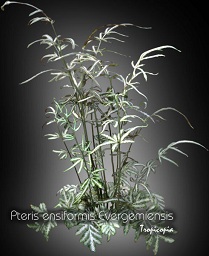Table of contents
Silver Lace Fern

Latin Name: Pteris ensiformis ‘Evergemiensis’
Category: Fern
Family: Pteridaceae
Origin: Asia
Climate: Tropical humid
Growing Zones: 10-9
Care Instructions
The Silver Lace Fern (Pteris ensiformis ‘Evergemiensis’) is a tropical humid plant that originates from Asia. This fern plant belongs to the Pteridaceae family and is well-suited for growing in USDA zones 10-9.
Complete Care Guide for Silver Lace Fern (Pteris ensiformis ‘Evergemiensis’)
Watering Requirements
The Silver Lace Fern thrives in consistently moist soil, making proper watering essential for its health. It is important to keep the soil evenly moist but not soggy. Water the fern when the top inch of soil feels dry to the touch. During the growing season, which typically spans from spring to early fall, you may need to water more frequently, especially if the plant is in a warm environment. In winter, reduce watering slightly, allowing the soil to dry out a bit more between waterings. Always use room temperature water to avoid shocking the roots, and ensure that the pot has good drainage to prevent root rot.
Light Conditions
The Silver Lace Fern prefers bright, indirect light but can also tolerate low light conditions. Direct sunlight can scorch the delicate fronds, so it’s best to place the fern in a location where it receives filtered light, such as near a north or east-facing window. If you notice the fronds becoming leggy or losing their vibrant color, it may be a sign that the plant is not receiving enough light. Conversely, if the fronds are turning brown or crispy, it may be getting too much direct sunlight. Adjusting the light conditions accordingly will help maintain the lush, green appearance of the fern.
Soil Preferences
The ideal soil for the Silver Lace Fern is a well-draining, rich potting mix that retains moisture without becoming waterlogged. A blend of peat moss, perlite, and compost works well to provide the necessary nutrients and drainage. It is advisable to repot the fern every couple of years to refresh the soil and provide more space for growth. Fertilization should be done sparingly; use a balanced, water-soluble fertilizer diluted to half strength every 4-6 weeks during the growing season. Avoid fertilizing in the winter months when the plant is dormant, as this can lead to nutrient buildup and harm the roots.
Pests and Diseases
The Silver Lace Fern can be susceptible to common pests such as spider mites, aphids, and mealybugs. Regularly inspect the undersides of the fronds for any signs of infestation. If you notice pests, treat the fern with insecticidal soap or neem oil, ensuring to cover all surfaces of the plant. Additionally, the fern can be prone to root rot if overwatered or if the soil does not drain well. To prevent this, ensure proper watering practices and use a well-draining soil mix. Fungal infections can also occur in overly humid conditions; maintaining good air circulation around the plant can help mitigate this risk.
Special Care Tips
To keep your Silver Lace Fern healthy and thriving, consider the following special care tips: First, maintain humidity levels around the plant, as ferns generally prefer a humid environment. You can achieve this by misting the fronds regularly or placing a humidifier nearby. Alternatively, placing the pot on a tray filled with pebbles and water can help increase humidity without overwatering the roots. Additionally, avoid placing the fern near heating vents or air conditioning units, as these can dry out the air. Regularly dust the fronds with a damp cloth to keep them clean and allow for optimal photosynthesis. Lastly, be patient; ferns can take time to establish and grow, so give your Silver Lace Fern the care it needs, and it will reward you with its beautiful, lacy foliage.








